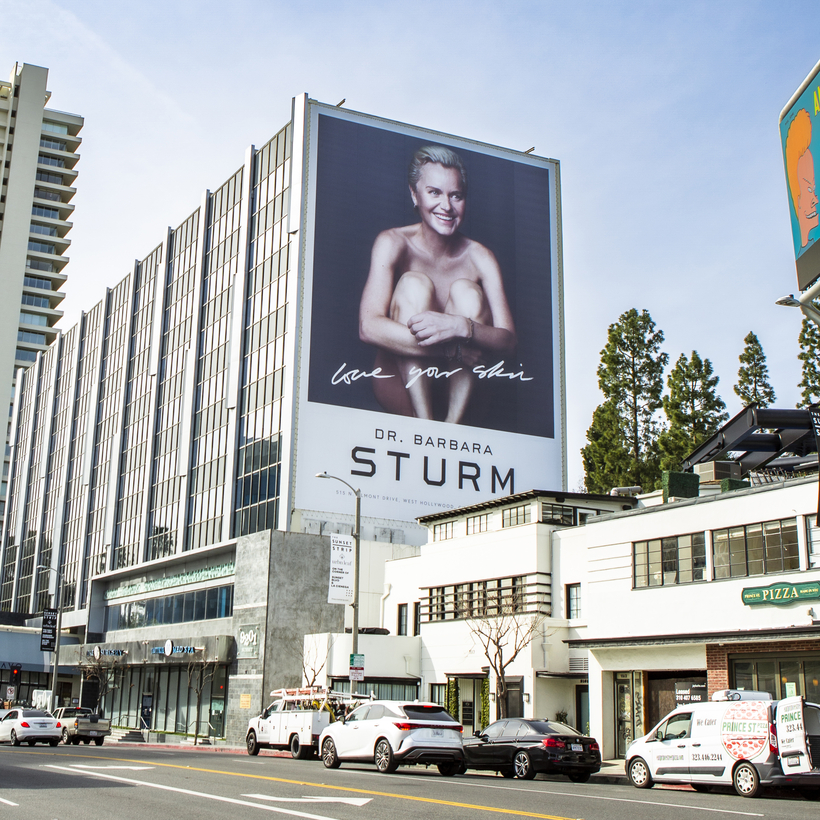The most important thing to know about Barbara Sturm is that she can turn blood into moisturizer. She can cook it up like a recipe committed to muscle memory. All she needs are some vials of you, some shea butter, and about five business days.
Almost everything else about her is perplexing. Nearly a decade ago, the skin-care savant arrived from Düsseldorf, Germany, at a press event in New York with a line of luxury products and a blood-soaked origin story. Since then she has become an object of fascination and some bewilderment. There’s her romantic life, which includes a past relationship with a Hollywood actor and a marriage to a lawyer with ties to Johnny Depp and a Russian oligarch. There’s her social life, with its seemingly constant candlelit dinners and its regularly scheduled black-tie galas. And there she is, smiling and naked, looking down at the traffic from a billboard above Sunset Boulevard.
Everybody loves Barbara. Victoria Beckham loves Barbara and uses her products. Stella McCartney loves Barbara even more—she presented Oprah with Sturm’s vaginal products in 2021. Since learning of Sturm’s existence eight years ago, I have made it my hobby to ask anybody who has ever had the pleasure of her audience what she is like, and nearly all of them say she has more charm than a Pandora bracelet. They are less confident in the details of her background, including those that pertain to her profession as the founder and she-E-O of Dr. Barbara Sturm Molecular Cosmetics. For one thing, she is not a dermatologist.
In 2002, when Sturm was in her late 20s and working in orthopedics, she took a sample of her own blood to a pharmacist, who in turn produced the very first prototype in the Dr. Barbara Sturm Molecular Cosmetics family of products: MC1. I call it the “blood cream.” The second-most important thing to know about Sturm is that her off-the-shelf skin-care line—the 50-plus members of the Dr. Barbara Sturm Molecular Cosmetics product family—does not include any human blood, thank you for asking!
Malcolm Carfrae, whose publicity firm, Carfrae Consulting, handles Sturm’s official communications, calls me one afternoon to gently but firmly remind me that the blood cream is not, has never been, an item available for purchase on the digital shelves of barbarasturm.com, nor atop the marble counters of its affiliated retailers. It’s not so much of a thing anymore; was it ever really a thing? And even if it was still a thing, it’s a thing that only happens on German soil, O.K.?
I tell Carfrae I understand. But I also tell him the truth, which is that the blood cream recalls the single most memorable stretch of my career as somebody who writes about beauty products: the time period in which, if you were somebody who writes about beauty products, and you found yourself with Sturm, and you were in a relatively private location, you might be offered the opportunity to bleed for her.

They bled in velvet-tufted hotel suites and town-house living rooms. They bled in conference rooms at Condé Nast and Net-a-Porter. They bled at the bar of the now-defunct Cafe Clover in New York’s West Village neighborhood while the scents of lavender waffles and quinoa pancakes collided in the air for one of the brand’s earliest recorded press events, in 2016. I didn’t get to go, but my boss at the time did. She returned to the office a few fluid ounces lighter, painted with a newfound glow. Not the glow that could, in theory, be delivered by the blood’s own healing proteins when applied topically to the skin—her blood cream would arrive a week later—but the incandescence of somebody recently exposed to an intense source of light. She had met Barbara, and she had fallen in love. The doctor’s charisma had seared her to the bone.
A platinum pixie cut, dark at the roots, swept upward and pushed behind the ears, provides a frame for the founder’s single best advertisement. Sturm’s face does not defy her age, which is 50 as of this month. Instead, it inspires onlookers to reckon with their own mortality, the transience of their own bodies, the glimmering possibility of self-preservation, and a $75 face wash.
Nearly all of them say she has more charm than a Pandora bracelet. They are less confident in the details of her background.
Any mention of Sturm’s work before her products took off in 2014, even when published in a newspaper or magazine, hews close to the narrative outlined in her company’s marketing: “Dr. Barbara Sturm is a German aesthetics doctor, widely renowned for her anti-inflammatory philosophy and her non-surgical anti-aging skin treatments.”
Various magazine articles and fans have described her as a former orthopedic surgeon, an orthopedist, a physician, an anti-aging specialist, and a rejuvenation expert, but I have not been able to independently verify the specifics of her medical training in Germany through her university or former colleagues. (Sturm’s lawyer asserts that she received her doctor-of-medicine certificate in 1999 in Germany.) After agreeing to an e-mail interview—Sturm was traveling, as always—I asked her to define the term “aesthetics doctor,” as well as offer specifics on her medical background. But, although I received e-mails from her publicist, I did not hear back from the woman herself.
Dr. Influence
One thing in this wild and beautiful world that cannot be denied is the persuasiveness of Barbara Sturm.
David Olsen, who led the beauty business for the luxury e-tailer Net-a-Porter, knew Sturm was extraordinary before their first meeting. “She is the hardest working person I know,” he tells me. Sturm had sent Olsen a cold e-mail introducing herself and explaining her brand. She had used her salary and a bank loan to develop six skin-care products, which she had been selling within her Düsseldorf practice. But now she was nurturing global ambitions. When she sent the sales numbers to Olsen, they were astoundingly good. Olsen almost didn’t believe her. He set up a meeting.
It was only after she flew to New York and entered the Net-a-Porter offices that Olsen realized Sturm was pregnant with her second daughter. She was brimming with energy. “I was really impressed with the brand,” Olsen remembers. “And then she took my blood in the office. I was a willing volunteer because I was so awed by her.”

Sturm’s line of skin-care products launched quietly on Net-a-Porter in 2014. By 2016, her products were also carried by the Hollywood-adjacent beauty boutique Violet Grey, as more deliberate public-relations and marketing strategies were beginning to form. The event at Cafe Clover occurred in the fall, generating headlines in outlets including the New York Post: “The hottest new beauty trend is your blood.”
“It really was her first big swell,” said a publicist who worked on Sturm’s brand after the MC1 event. “I remember all of our doctor clients were getting very pissy about Dr. Sturm because she was the new face on the scene. They were like, ‘Who is this woman?’”
Sturm began tinkering with blood after studying medicine and sports at a university in Germany. Then she met a group of orthopedists and scientists, with whom she helped “pioneer a treatment against osteoarthritis,” as she told Vogue in 2016. Peter Wehling, a Düsseldorf-based orthopedic surgeon, received attention from the American press around 2011 as athletes began to travel to Düsseldorf for blood-derived anti-inflammatory injections. One was Kobe Bryant, which inspired the term “the Kobe Procedure.” Bryant’s treatment is referenced in Sturm’s marketing. (Wehling did not respond to requests for comment.) Sturm opened her own clinic in Düsseldorf in 2006, well before Bryant’s arrival.

When she and a friend attended a seminar on face-shaping hyaluronic-acid injections, Sturm was taken with how skin could be sculpted from within—but wondered if blood wouldn’t make for a better fill. “I came up with the blood facial probably seven years before vampire facials,” she told the facialist Joanna Czech, referring to platelet-rich plasma, or P.R.P., treatments, in a feature that was published on Czech’s Web site.
The process of verifying Sturm’s involvement in the invention of the P.R.P. facial is both difficult and painfully boring. Articles about Sturm’s product line in magazines including Vanity Fair and Vogue credit her with inventing the procedure. Trend pieces on P.R.P. facials began appearing around 2011 and reached a fever pitch in 2013, after Kim Kardashian received one on-camera, although none of the articles mentioned Sturm. (Sturm did not administer Kardashian’s Vampire Facial, which was broadcast on an episode of Kourtney and Kim Take Miami.) In a TikTok post last January called Why did I create the Vampire Facial?, Sturm merely explains the first blood cream, made in 2002, that inspired her eventual skin-care range.
It is also worth noting, says the Fairhope, Alabama–based physician Charles Runels, that the “Vampire Facial” was trademarked in 2013 by the Fairhope, Alabama–based physician Charles Runels. His intent was to standardize the vampire-facial procedure—a combination of micro-needling and P.R.P—which could be dangerous if performed incorrectly. “Imagine you want to buy a gourmet filet, but all the signs just say beef,” he tells me. “And you can’t tell whether you’re going to be getting a McDonald’s hamburger or a gourmet filet. Do you see the metaphor?”
Alongside her budding skin-care business, Sturm also administered a variety of injections—first at her clinic in Düsseldorf, and then in a smattering of unusual locales. One editor told me she was offered Botox on the patio of Sturm’s suite at the Hotel Bel-Air; another received an injection of fat-dissolving Kybella in one of her knees during a routine facial at a salon in New York City.
They bled in velvet-tufted hotel suites and town-house living rooms. They bled in conference rooms at Condé Nast and Net-a-Porter.
From 2016 to 2018, Sturm claimed year-over-year revenue growth of 300 percent on the Glossy podcast, generating some $15 million in sales in 2018, and all without advertising, according to Sturm in The Wall Street Journal. (“I think product gets transported best through word of mouth,” she told The Wall Street Journal.) In the early months of the pandemic, when skin-care sales saw a category-wide boost, Sturm said hers soared, quadrupling in 2020.
Now the brand is reportedly raking in about $150 million in sales annually, dwarfing its previous records. Part of this growth is fueled by an unceasing deluge of new formulations, which has increased Sturm’s purview from the face to everywhere else on the human body. There are vitamins and teas; there are scalp scrubs and baby shampoos; there are even collaborations that veer into cashmere and footwear.
Sturm’s skin-care line for Darker Skin Tones, launched in 2016 with insights from Angela Bassett, was both a prescient feat of marketing and a solid range of products for an underserved luxury customer—one full year before Rihanna’s Fenty Beauty hit shelves. Her Sun Drops, a milky emulsion, blesses any cream or foundation or bare skin it meets with S.P.F. 50.

These successes haven’t stopped the whispering and sniping among her competitors, though. One dermatologist tells me, “Everybody in the dermatology sphere is jealous of someone who has been able to absolutely kill it who’s not even a dermatologist.”
Her job is not to be a doctor, or spokesperson, or social-media influencer, or occasional nude model, or full-time traveling saleswoman, but to be all of those things, and to also look dewy. This is the genius of Barbara Sturm.
She works as a diplomat for her own sovereign nation, moving like liquid across borders. She travels about 300 days a year to her homes in Düsseldorf, Los Angeles, and Gstaad, Switzerland, and to luxury hotels in New York, Miami, London, and Dallas, networking at a delirious pace. Sturm manages to forge connections at every rung of the influence ladder. I was shocked and a little delighted to discover that the only party photo of me ever taken was with Sturm herself, when I worked at Allure.
But building an international skin-care brand is not a one-woman job, even if that woman is more than capable of doing it on her own. “Most dermatologists aren’t skilled at building brands,” says Ellen Gendler, a board-certified dermatologist. “They’re doctors. More often than not, they hire people who can handle the brand, so they themselves can handle the product.”
Olsen remembers how Sturm commanded their initial meeting. From the jump, it was clear that she was the heart, soul, and face of the operation. But she wasn’t alone. She had also brought her husband, the company’s executive chairman, Adam Waldman. He spoke less, but the two left a glamorous impression. “I just remember they got married at Cher’s house,” Olsen says.
Dr. Sturm and Mr. Drang
Waldman and Sturm were introduced by Cher, who was a mutual friend and a client of Waldman’s. Sturm was fresh off a six-year relationship with the actor George Hamilton. In 2013, Waldman and Sturm were wed in a Buddhist ceremony at the singer’s cliffside Malibu property before friends, family, Will and Jada Pinkett Smith, and the glittering Pacific expanse. “I have already sorted out his entire wardrobe,” she told the German magazine Bunte, which covered the wedding. “And raised his eyebrows and [had] his cheeks lifted.”
Together, they also raised the company’s presence in Sephora, Nordstrom, Bloomingdale’s, and Saks Fifth Avenue, and with Dr. Barbara Sturm boutiques in some of the most expensive real estate in New York City, Los Angeles, Palm Beach, Miami, and London. It takes a lot of Super Anti-Aging Serum—even at $900 for 100 milliliters—to pay for a lease on Mount Street.
To say that her husband is influential would be putting it both mildly and neutrally. Waldman is the co-founder of Endeavor Group, a Washington, D.C., advisory firm that has assisted a number of high-profile clients.

On social media, he enjoys some renown due in part to his representation of the actor Johnny Depp during his relentlessly public legal battle with his ex-wife the actress Amber Heard. According to The Hollywood Reporter, Depp and Waldman were introduced by Abdulaziz bin Salman, the fourth son of the King of Saudi Arabia and the nation’s minister of energy.
Since that meeting, Depp has become arguably less known for his work as an actor, musician, and Dior spokesperson and arguably more known for his work taking the members of his once innermost circle to the cleaners. Waldman represented Depp in his lawsuits against his longtime business managers and his longtime entertainment lawyer. And certainly you heard about Heard?
Depp lost an initial libel case, filed in the United Kingdom against the tabloid The Sun. A second case, filed in the United States in 2019 and decided in 2022, was eventually successful in awarding Depp and annihilating Heard. Despite Waldman’s removal from the case, in 2020, after it was discovered that he had leaked privileged information to the press, he remained a central character in the legal saga.
To say that her husband is influential would be putting it both mildly and neutrally.
Another notorious former client of Waldman’s was Oleg Deripaska, a Russian industrialist and friend of Vladimir Putin’s. From 2009 to 2019, Deripaska paid Endeavor a $40,000 monthly retainer “to provide general legal advice on issues regarding his U.S. visa,” which had been suspended due to suspected ties to organized crime. (Deripaska has denied such ties.) Waldman and his firm no longer represent Deripaska. (Waldman declined to speak with AIR MAIL on the record.)
Sturm and Waldman have been living among their three homes and have traveled together extensively. (They have also been regulars at Oktoberfest in Munich, where Deripaska joined them in 2015.) Sturm told one magazine that she and Waldman FaceTimed throughout the day when they traveled and got couples massages when they were together—Swedish for her, Thai for him.
Their business relationship, at least, has changed recently, as Sturm’s lawyers confirmed that Waldman is no longer a director in any of the companies in the Sturm Group.
But according to the Instagram record, life remains one big never-ending adventure. On her personal account, @bbsturm, Sturm regularly shares snaps and videos of her photogenic children and enviable ski skills, alongside skin-care tutorials. Wherever she is, she is radiant. Her hair is perfectly slicked back, her smile is wide and bright, and her face looks devoid of makeup. As far as anyone can tell.
Brennan Kilbane is a New York–based writer. He is originally from Cleveland, and his interviews and essays have appeared in GQ, New York magazine, and Allure, where he was recently on staff as a features writer





